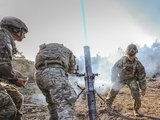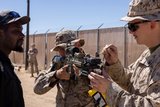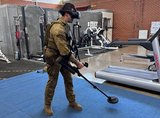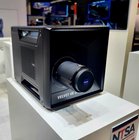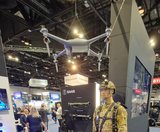New mixed reality pilot training delivers tactile advantage
Capt. Juston Kuch operated a simulated T-45 Goshawk. (Photo: US Navy/Petty Officer 2nd Class Molly Tice)
The US Office of Naval Research’s TechSolutions programme has showcased a new approach to simulation training based on mixed-reality technology at Naval Air Station Meridian, Mississippi.
The T-45C Goshawk mixed reality simulator, also known as Project Link, combines the advantages of virtual reality (visualisation of a broad environment in high definition, to deliver situational scenarios), with the physical reality of a cockpit, to deliver tactile contact and build muscle memory.
The programme describes the Goshawk as “a better way to prepare future Navy pilots”.
Related Articles
BAE Systems and VRAI collaborate on data-driven pilot training
The mixed-reality simulator was created in response to a request from Lt. Cmdr. Geoffrey Dick, T-45C chief standardization pilot at Naval Air Training Command (CNATRA).
Training new strike pilots can take up to two and a half years, with much of that time is spent in the classroom. Nobody is necessarily arguing yet that a new approach to simulation will do away with the classroom time, which remains necessary before trainee pilots get their hands on any simulator. But Dick believes the mixed reality approach will better prepare students for an important aspect of their training by them physically engaging with a cockpit with low risk. The new system was also designed to be low cost, with a small footprint and easy deployment.
“We want them to be able to flip switches, turn dials – physically interact with the cockpit,” Dick explained. “Virtual reality didn’t quite get us there because of the fact that there's no cockpit built into it. You’ve got to kind of move your head around, then stare at something and pull the hand trigger to select it, which introduces the possibility of a negative transfer of training.
“Mixed reality should help solve that problem,” he added.
As much as the mixed reality approach is expected to improve the intuitive nature of the simulators used by trainee pilots, TechSolutions claimed the development of the simulator was at at least as impressive from a time and creativity standpoint.
Jason Payne, director at TechSolutions, said: “We received a request about a year ago and began working on the solution for a mixed reality training program almost immediately. The development team at Naval Air Warfare Center Training Systems Division quickly prototyped the solution and we’re now delivering a new capability to the fleet.”
TechSolutions said it would be constantly on the lookout for suggestions and requests from Sailors and Marines who have firsthand knowledge of what was needed to fulfil their mission, from which to build additional simulators that could cut down training time and ramp up the intuitive nature of any future training.
Related Programmes in Defence Insight
Future Aircrew Training Program (Fixed-wing Aircraft Procurement) - Canada
More from Training
-
![Cubic tailors mortar simulator for the US Army]()
Cubic tailors mortar simulator for the US Army
The company’s mortar trainer received improvements based on soldier’s feedback.
-
![Saab expands footprint in the US]()
Saab expands footprint in the US
The company will operate in two new locations in the coming years to better support US services.
-
![I/ITSEC 2024: Australian Army approaches second phase of countermining training]()
I/ITSEC 2024: Australian Army approaches second phase of countermining training
The Engineering Corps has been conducting individual instruction using FLAIM Systems’ Sweeper and should start collective deployments in 2025.
-
![I/ITSEC 2024: Zeiss introduces Velvet 4K SIM projector for night flight simulation]()
I/ITSEC 2024: Zeiss introduces Velvet 4K SIM projector for night flight simulation
The next-generation platform is motion-compatible and can be used in OTW and NVG applications.
-
![I/ITSEC 2024: Saab introduces UAV live training capability]()
I/ITSEC 2024: Saab introduces UAV live training capability
The system can be used to prepare soldiers for both drone offensive operations and CUAS missions.










